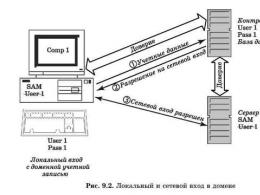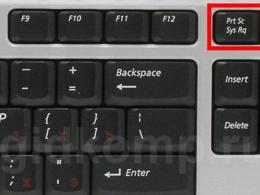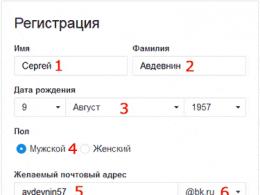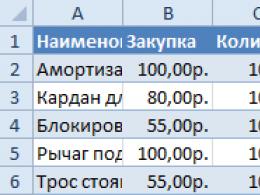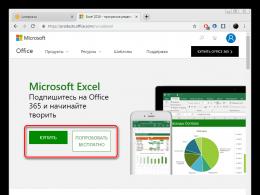How to properly format a hard drive or drives: methods and programs - detailed instructions. Formatting a hard drive through the Windows command line
For certain reasons, PC users sometimes really need to format HDD. There are many options for how to do this. By itself, this process is complete cleaning"hard" from the information that is on it. Most often used when changing the operating system. Before you need all necessary information save on any other medium. For example, on a disk, flash drive or external drive.
Through the command line
The easiest way to format a hard drive is to call the console. The command line starts like this:
- click "Start";
- from the "All Programs" list, select "Accessories";
- in the podcast that opens, select "Command Prompt".
But then you need to specify which disk will be erased entirely. Let it be "C". You must enter "format c:" in the console. Before formatting the hard drive, the system will warn you that all data will be wiped clean and ask you to confirm the decision. You can call the command line even if the computer is damaged by viruses. Just press F8 during system boot and select start in safe mode with console support. Depending on how heavily loaded the disk is with information, formatting takes from 10 minutes to an hour. At this time, you just need to wait without pressing anything. Or mind your own business.

Through "My Computer"
The most accessible way for all users to completely format a hard drive is to select the drive itself from all available in the folder. You need to go to "My Computer" on Windows XP or "Computer" on other versions. Among all the disks that are, select the one that you will erase. Right-click to open the context menu. Select "Format Disk". Read the question from the system carefully. It is worth noting that before formatting the hard drive, you need to log into the system in administrator mode. Otherwise, the option may not be available (on some versions of operating systems). The operation takes long time if the disk is full of information. It is noteworthy that in this way you can remove any hard, regardless of whether there is an OS there or not. That is, you need to be extremely careful when using a PC, especially if children have access to it.

How to format a hard drive?
Speaking about such a procedure as deleting and cleaning all files on the device, one cannot fail to mention the method with special optical discs. Specifically, those where there is already a new operating system. Everything is simple here: you need to insert a disk into the drive and wait until it spins up. Then you just need to follow the steps. One of them will be how to format the hard drive. If the hard is virtually divided into several parts, then the system will offer to delete both or only one. The one where the operating system is located (by default, this is drive C). That is, the information on other disks will remain untouched. Attention, if there are viruses in the system and malware, then both must be removed in order to prevent viruses from spreading in the computer. If the knowledge is not enough to carry out all the steps correctly, contact the specialists who will format everything quickly and without harm to your PC.
 Hello everyone Today we will talk about how to format a hard drive using the command line. And you know what I'm going to tell you here? Here is this info, well, I mean formatting hard drive across command line, then you need to know this info! This information, so to speak, is included in the list of the most important information that a more or less advanced user should know.
Hello everyone Today we will talk about how to format a hard drive using the command line. And you know what I'm going to tell you here? Here is this info, well, I mean formatting hard drive across command line, then you need to know this info! This information, so to speak, is included in the list of the most important information that a more or less advanced user should know.
My opinion is that everyone should be able to work with the command line. Well, not everyone, just if the computer suddenly breaks down, then you know how to use the command line, then this knowledge can be very, very useful to you, I honestly tell you!
I think that you do not need to say that formatting a disk will completely delete all files on it, everything in general, and programs and all sorts of pictures, music, everything will be deleted on the disk that you format! I hope that you understand this already, but I still had to write about it ..
Okay guys, back to our topic, namely, how to format a hard drive using the command line. This can be done both from Windows itself and when loading it, but the main thing is that all the actions are the same, you just need to clearly understand what's what, and that's exactly what I'll show now. So look, if you will do all this in Windows (but keep in mind that at the same time system disk you can’t format it, because it has Windows on it), then you need to hold down the Win + R buttons, the Run window will appear, there you write the cmd command and click OK:

Then a black window will appear, like this:

Well, I think that you already understand that this black window is the command line. Here you can enter all sorts of commands and do something. In general, you can do a lot of things. To see a list of all commands, you need to type the following command in the line:
And press enter, after which you will see the following list of commands:

You can take any team, well, the very first one on the list is ASSOC, so let's take it. Well, you can take any command, then add a space to it and something like /? and then press enter and there will already be a mini-instruction for this particular command. Well, look, I wrote the following command:
I pressed enter and this is what I thought:

Well guys, in principle, more or less clear, right? That is, in this way you can somehow learn to use the command line yourself. But it's certainly a bit boring, but what can you do! Today I will show you how to format a disk using the command line, for this you need to use the following command:
Yes, you can look at the help on it, I have already shown how, but I think it would be better if I personally tell you about it, since I myself have already used it more than once. And I didn’t use it just like that, there is one feature in this team, you may not be interested in it, but I’ll tell you about it anyway ...
So what needs to be done to format the disk with the FORMAT command? You need to write the following command:
FORMAT C: /FS:NTFS /X
This is a standard command, it will format the disk in the usual way, so to speak. Where the letter C is, then there you specify the drive letter. Such as / FS: NTFS is necessary in order for the disk to be formatted in the NTFS file system, it is also possible in FAT32, but I advise NTFS. Such as /X is necessary to force the disk to be forcibly disconnected before formatting, this is just to make sure everything goes right. Attention guys! This command does regular formatting, that is, as it were, not so fast, if you need everything to go quickly, then you need to add the / Q key, that is, so that it is like this:
FORMAT C: /FS:NTFS /X /Q
It will already be much faster and you won't have to wait. For without the /Q key, formatting can take a long time if the hard drive is not small .. well, there is from one terabyte or more ...
It seems to be everything, right? But I wrote about the chip, what kind of chip? Now I'll tell you guys everything .. The trick is that there is also such a key /A: 64KB, this key, this is so that the cluster is changed during formatting. A standard cluster is 4KB, that is, 4 kilobytes. What can be the size of the cluster in general, you can see it in the help for the FORMAT command. What is a cluster? I will not load you, I will say that the cluster is the minimum unit that can be occupied on the disk.
So, about the cluster, look. Here, a cluster of 4 kilobytes is usually placed on the hard disk. That is, if you have a file of 100 kilobytes, then it will be written in small parts of 4 kilobytes. Not always Windows writes the file at once entirely in one area. Usually part of the file is in one place, and the other part is in another, this is called fragmentation and this is a normal phenomenon, as it were. Do you understand? As a result, we get this: if a cluster costs 4 kilobytes, then the file can have many parts and they can easily be scattered throughout the hard disk, and in order to read the file, it takes, as it were, more time than if the file was written in one piece. If there is a cluster of 64 kilobytes, then a file of 100 kilobytes will have only two parts on the disk, these are 64 kb and 64 kb, because the file will fit into these parts completely. What remains, well, I mean two clusters is 128 kb, and the file is 100 kb, then nothing can be written to the remaining 28 kb, this is the only minus of a 64 kb cluster. It seems that there are no more minuses, well, at least I don’t see them. A 100 kilobyte file will only have 2 parts in a 64 kb cluster versus 25 parts in a 4 kb cluster, you know? Once again, about the minus that I wrote, in other words, a 100 kb file on a disk with a 64 kb cluster will take up 128 kb of space. Because two clusters are 128 kb. Well, I hope that is more or less clear, and if not, then I'm sorry, then I explain poorly ..
In general, I personally always set a 64 kb cluster, I like it more, my mother also has a computer and I also set 64 kb for her and the computer seems to work faster. But if you think about it, then in theory it should work faster. A 64 kb cluster is the best cure for fragmentation, but does not eliminate it completely..
So what should be the command so that the cluster is 64 kb? I personally use this:
FORMAT C: /FS:NTFS /X /A:64KB
A cluster of 64 kilobytes is maximum size for file NTFS systems. Well, you can also specify the / Q key to make formatting faster.
There is another joke. The fact is that there may be such a jamb that Windows does not want to be placed on a disk with a 64 kb cluster, there is such a thing. This is how I do it here. At first, I just stupidly install Windows, format the disk and everything is as usual. Then I reboot and go to system restore and there I launch the command line, the system disk, well, that small, service disk of the type, it is usually 500 mb, I DO NOT TOUCH it AT ALL. And the one where Windows is, then I put the FORMAT command on the command line and put a 64 kb cluster there and format it. Then I install Windows again, I don’t format ANYTHING in the installer, but simply select the disk (which I formatted in a 64 kb cluster) and install it. As a result, Windows is quietly installed on a disk with a 64 kb cluster
In fact, all this confusion with clusters, then I need this, but this is not a necessity, almost all users sit with a 4 kb cluster and are happy with everything .. So you don’t have to worry about it, if these clusters are not interesting to you, then you shouldn’t change the cluster, this is so, my jokes would say so.
Keep in mind that on the command line, well, where the installer is, there is still a button Restore Windows or something like that, then there, on that command line, there the system disk can easily NOT HAVE THE LETTER C, but another, keep this in mind, because it is important! How to resolve the situation here? First you need to find out in general which sections which letters belong to. To do this, you enter the following command:
And then write this command:
And you will see what sections there are and what letters belong to them, look how I have:

Then, when you have looked, you need to enter this command:
This is to get out of the DISKPART subsection so to speak:

You will also be helped by such information as the size of the disk, it is also easy to understand what kind of disk it is. There is also a command that will show you what is on the disk, this will also help you understand where which disk is, well, for example, to see what is on drive C, you need to write the following command:
And here is the result:

Another good thing is that the size of the disk is also displayed here.
Here is another command:
This is to go to the directory, well, here, for example, just drive C is indicated above. Well, guys, everything seems to be more or less clear? I really hope so!
That seems to be all .. And if something is wrong, then I'm sorry. By the way, it's now December, the 22nd, and therefore I congratulate you on the upcoming New Year 2017 .. I wish you happiness and that everything is fine with you .. By the way, the year of the rooster ..
23.12.2016Sometimes there are situations when you need to clean the hard drive, that is, format it. C, D, E or whatever. But in most cases, Windows is installed on the logical drive C. She won't let you just clean it up. The rest are easy to clean.
There are three types of formatting:- We have nothing to do with the low-level. After all, it is produced at the assembly plant using special equipment. V service center, not to mention home conditions, it will not work.
- The second formatting method involves dividing the logical media into several smaller sizes. That is, instead of one, we get two or more disks. This manipulation can be carried out only when installing the OS.
- The third kind is high-level formatting. It is divided into two subtypes. In the case of a quick format, the files remain in their places, only the file table is updated, and the OS sees the disk as empty. This is very convenient when we do not want to completely lose data or have formatted by mistake. With full formatting, all information is erased without return, in addition, the system checks the device for serviceability. If problems are found, data will not be recorded.








Thus, from this article you have learned how the process of formatting a hard drive in Windows OS goes. There is nothing complicated about this, as you can see, finally consolidate your knowledge by watching a thematic video.
Many users believe that formatting is nothing more than a preliminary removal of all data from the hard disk in order to write new ones. This is true, but in fact, deleting data from the hard drive is a side effect of formatting. This procedure is of two types: low-level and logical.
- Low-level formatting of a hard drive is done at the production stage. In this case, the markings necessary for the correct positioning of the heads are created on the “screw”.
- Logical, is executed after it is partitioned into sections, which are named: drive D: \ E: \, etc. Logical formatting creates a boot sector, file structure, and partition table with a boot entry. All disk space of the formatted "screw" is divided into clusters.
In addition, formatting can be normal or accelerated. With the usual one, the file structure is deleted and broken clusters are checked, which are rejected and are not used for recording information in the future.
With quick formatting, only the file table is deleted. All new data is written over the old.
Working with the hard drive using standard Windows OS tools
Many people ask how to format a hard drive using their own operating system. There is nothing easier:

If you decide to format the hard drive partition where your operating system is located, then it is impossible to do this using Windows tools. This operation must be done through DOS and using any LiveCD.
If you are wondering how to format a hard drive through BIOS, you should read the instructions to the end and follow all the steps described below.
Formatting a “screw” through BIOS should mean using boot disk, which is launched by setting the device in the BIOS.
- Restart your PC.
- Before starting the OS, enter the BIOS, select the BOOT tab, where select required device(depending on what media the boot disk is on).
- Save changes and restart your PC.
- After loading the disk, press the key combination Shift + F10.
- After opening a command prompt, type format /FS:NTFS X: /q - where X is the required partition. For file fat systems 32 type format /FS:FAT32 X: /q - where X is the required partition.
- Then press Enter and type Y as confirmation.
Now it remains only to wait.
Working with a hard drive when installing Windows

Working with the hard drive with third-party programs
There is a mass software solutions to work with disks. Most popular program For formatting a hard drive, this is Acronis Disk Director Suite. It is very easy to use, and is most often present in various LiveCD builds.

Questions and answers
- Several hundred people daily ask our specialists the question: how to make low-level formatting hard drive from a flash drive.
In fact, there are times when removing a virus requires deleting the entire boot sector. And for this there are certain software tools, such as SeaTools for DOS. During the standard launch of this program, it creates bootable USB the media from which the loading and selection of one of the three types of hard drive cleaning takes place.
In fact, such a procedure cannot be called a completely low level, but the possibility complete removal data with the removal of the zero track and hard disk, as well as filling the entire disk space with zeros, is closest to the concept of low-level formatting.
- How to completely format a hard drive so that the data on it cannot be recovered?
Indeed, even after reformatting, data can be recovered with special software tools. If you need to permanently delete all information from the hard drive, for example, when reselling a PC, then use the Eraser HDD program to completely format the hard drive.
After downloading, the program is immediately ready for use and does not require advanced settings. By pressing the Start button, you will see a list of sections of your "screw" under the numbers. Select the number of the partition that requires full formatting, paste it into the box and click Apply. After that, you will be asked for confirmation for the last time about the permanent deletion of all information. After confirmation, reboot, and go through the procedure for initializing the hard drive.
Command line - powerful tool operating room management Windows system. With it, you can do almost everything that is usually done with GUI. In this article, we will talk about how to format a hard drive or flash drive using the command line.
Step #1: Launch Command Prompt.
If you want or through the command line, then first of all you need to run this command line. At the same time, otherwise you will not be able to use the command for formatting.
There are several ways to run Command Prompt with administrator rights. The easiest option is to use the search in the Start menu. To do this, open the Start menu, type in the search command "CMD", then click right click mouse on the command line and select the option "Run as administrator".
If you are using operating system Windows 8 or Windows 10, then you don't even have to use search. Just press the key combination Windows + X and in the menu that appears, open the item “Command Prompt (Admin)”.

After that, a warning from User Account Control will appear. To continue, click on the "Yes" button.

As a result, you should open a command prompt with administrator rights. The presence of administrator rights will be indicated by the inscription "Administrator" in the title of the command line window.

Step number 2. Executing a command to format a hard drive or flash drive.
After the command prompt with administrator rights is launched, you can start formatting. For formatting through the command line, use the "FORMAT" command. To get all the information about this command, type "FORMAT /?".

In order to format a hard drive or flash drive, you need to use the correct parameters along with the FORMAT command. At a minimum, you must specify the letter of the drive you want to format. For example, like this "FORMAT D:". In this case, the standard settings will be used for formatting.

Please note that before formatting a hard drive or flash drive, you will be asked to enter a volume label (disk name). You need to enter the current volume label, not the one you want after formatting. You will also need to confirm the formatting by entering the letter Y (from English YES).

A new volume label can be set after formatting is complete. If a new label is not needed, then you can simply press Enter and the system will use for this disk standard volume label.

By adding other options to the "FORMAT D:" command, you can control formatting more finely. For example, by adding "/FS:FAT32" you can format the drive to the FAT32 file system. And the “/Q” parameter allows you to quickly format a hard drive or flash drive. As mentioned above, to get information about all possible parameters of the FORMAT command, you need to execute "FORMAT /?".

